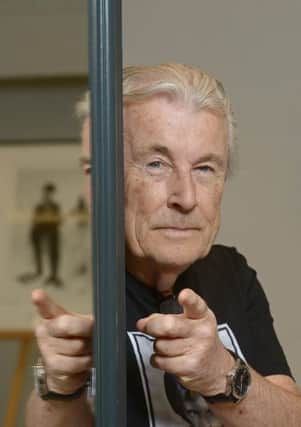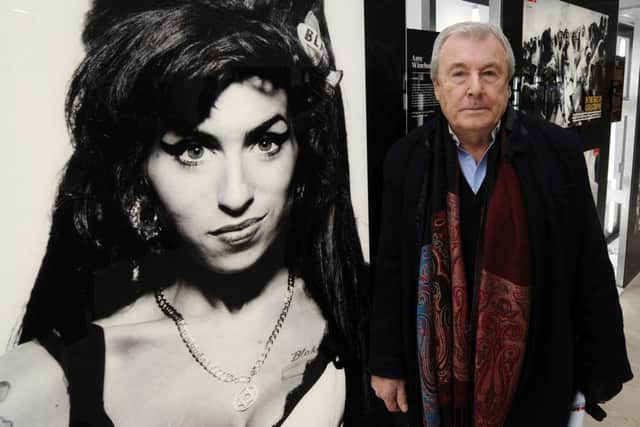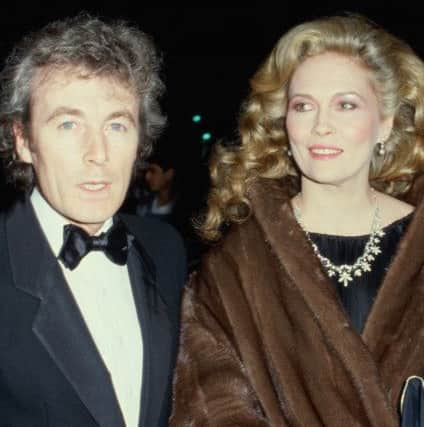Interview: Terry O'Neill


“I hate it. I’m not interested in being photographed,” he says, then explains. “Because I know what it’s like and I feel for the photographer. I mean, the photographer feels as bad as I do, when you have to photograph another photographer.” For his part he’s photographed some of the greats – Avedon, Demarchelier, Penn, Parkinson, Bailey – but it was photojournalist Eugene Smith who first caught his eye.
“That was the type of picture I started doing, but I ended up doing showbusiness and all that,” he says, displaying his matter-of-fact approach to a 60-year-career capturing the glamour and candour of some of our greatest political, sporting and showbiz icons, from Mandela to Ali and Churchill, Chuck Berry, Elvis, The Beatles, The Stones and Bowie, Bardot, Audrey Hepburn and Amy Winehouse.
Advertisement
Hide AdAlways happier behind the camera, O’Neill’s star nevertheless rose along with his subjects’ as they blazed a trail through the 20th century. Inspired by reportage, he took photography out of the studio and applied a more informal, intimate style to capturing the emerging faces of the Swinging Sixties. If they were famous, O’Neill has photographed them.


His easy manner meant big names trusted him and gave him access all areas, allowing us to see their human side. Michael Caine calls him “one of the best photographers in the world” and a friend, Frank Sinatra recruited him to his pack and Faye Dunaway married him. He’s still friends with Bill Wyman, Charlie Watts, Eric Clapton, and Terence Stamp. Now, after a lifetime training his lens on the stars, 79-year-old O’Neill has time to step out from behind the camera to tell the tales behind his archive of four million negatives.
“I look back at all the pictures and I can’t believe the life I’ve had. They’re all memories for me,” he says.
Today we’re focusing on his relationship with Bowie, who O’Neill photographed many times over the years. The images are familiar – Bowie and the huge hound on the Diamond Dogs shoot, Bowie as Ziggy, Bowie looking wired in his mustard Thin White Duke suit – hanging on the walls of jeweller Chisholm Hunter in Edinburgh’s Princes Street. O’Neill arrived on his whistle-stop tour to talk about photographing the singer and launch a watch created by Swiss luxury watchmaker Raymond Weil in celebration of what would have been the singer’s 70th birthday. The Freelancer David Bowie Special Edition references three of Bowie’s personas: the iconic Aladdin Sane thunderbolt, the Warhol Bowie logo created for Diamond Dogs on the dial, and on the reverse a 1974 O’Neill portrait of The Thin White Duke.
But the persona closest to Bowie, says O’Neill, was the one he played in The Man Who Fell to Earth.


“It just summed him up. He wasn’t like a normal human being. He was a very intelligent, very bright guy ... not like a pop star at all. You know, nobody I ever met was like him ... ever. He just stood out, you know. They stand out, these people. He was a great, great guy ... I’m really pleased to have known him.”
Advertisement
Hide AdIn person, it’s easy to see why O’Neill charmed the stars into letting him behind the scenes.
Ask him to dish the dirt on difficult celebs and he says he’s never had any. Really?
Advertisement
Hide Ad“Not really, no. People are really nice to me. Or I’m nice to them, I don’t know what it is,” he says and laughs.


Grey hair neatly styled, he’s modestly dressed in black, but closer inspection reveals his monochrome T-shirt design to be one of his Bowie pictures – “the mustard suit, his cocaine period,” he says in a soft Cockney voice that immediately puts you at ease. He’s engaging with a quiet East End charm, and eyes that twinkle as he reels out an anecdote for every picture.
As well as the photographs, O’Neill has brought copies of his book, When Ziggy Played the Marquee, a visual record of the singer’s last performance as Ziggy Stardust in the Marquee Club in 1973. O’Neill was invited to take photos of Bowie and spent a day capturing the musician and band backstage as well as shooting the show.
At the time O’Neill was a huge jazz fan – he’d always wanted to be a jazz drummer, still does (“But who would I play with? They’re all dead now, the greats, Stan Getz, Zoot Sims, Oscar Peterson) – and idolised Sinatra, for whom he became set photographer on several of his films. He wasn’t that fussed about Bowie’s music at first, truth be told.
“I didn’t like his voice,” he says, “because I’m a jazz fan, a blues fan, and not really into that type of music. But he was a fascinating guy to work with. It was like working with an actor, that’s the way I approached him: as an actor, not a pop star. And the music grew on me in the end.”


I’m guessing that the charming Mr O’Neill didn’t let slip to Bowie that he wasn’t always singing along to his hits at first.
Advertisement
Hide Ad“No, no,” he laughs. “Actually it helped me concentrate on the job. Because when I worked with Elton, you can get carried away with the music and forget what you’re doing.” O’Neill was official photographer of John’s two-day Dodger Stadium performance in front of 100,000 fans in LA in 1975 and photographed the cover for his Greatest Hits album.
Ask him about his favourite Bowie memory and there are so many he has to stop and think.
Advertisement
Hide Ad“Aw God, all the time I spent with ‘im. But... talking about trouble… the one time… Liz Taylor wanted to meet him because she was thinking about offering him a part in a film she was doing in Russia, The Blue Bird, and she said bring him to [the director] George Cukor’s house at two o’clock. So I get over there, two o’clock right, she’s there, everyone’s there, he never turns up till six o’clock. I mean he was out of it to be honest, but she’s such a pro, she wasn’t annoyed. She took over the shoot and we did two, three rolls of film and that was it. He never got the part in the movie, I might add, but they did end up good friends in the end. You couldn’t help liking him, because he was such a nice guy.”
Perhaps because O’Neill is unfazed by celebrity and lacking in pretension himself, he never suffered nerves around the rich and famous.
“Apart from when I had to photograph the Queen,” he says. “I worried every day for three months about what could go wrong, then I walked in and straight away she put me at ease. She’s incredible, the Queen. I told her a horse racing joke and I was off and running. She was a great person to photograph, fabulous.
“Frank Sinatra was another, a great man to work with. Aw, there he is there,” he says and points out a black- and-white image on the wall. “He was incredible. When you worked with him, you knew you were the best. He had the best musicians, the best of everything and he was a great, great guy – a photographer too, you know.”
As well as putting stars at their ease, O’Neill also had a talent for seizing the moment. When the wind whipped Brigitte Bardot’s hair across her face as she enjoyed a cigar on the set of The Legend of Frenchie King, when he bumped into Sinatra on the boardwalk in Miami with his heavies, or caught up with Bruce Springsteen outside Tower Records on Sunset Boulevard, he had his Leica, Hasselblad or Nikon in hand.
“Across the road on a billboard was that sign, Born to Run. I couldn’t believe it. So I said ‘Let me get you by that’. He loved it. Such a nice guy, Springsteen. I mean they’re all nice, you know.”
Advertisement
Hide AdAre they? Is there really no-one who’s horrible, a stroppy foot-stamping diva that made his life hell?
“No.”
I’m disappointed, so the obliging Mr O’Neill thinks again.
“Well, Steve McQueen wasn’t very nice. But that was because he was put in a situation. I went to photograph him for a Sunday supplement, and when we walked in he said he’d told the PR he didn’t want to do it, so I started taking pictures as he had this row with the PR and by the time they’d finished I’d got the picture. So I’d got him, but he wasn’t a very nice guy.”
Aw, he’s just burst my Steve McQueen bubble.
“Sorry. I KNOW, sorry. He’s an all- time great, but…”
Advertisement
Hide AdBorn 1938 in Romford, Essex, the son of Leonard, a foreman at the Ford car plant and Josephine, a housewife, O’Neill had steered well clear of his dad (“he was a big drinker and didn’t act like a good father. He DID in the end, but it was all too late”) focusing instead on his Box Brownie and photography in general.
“I thought people who took pictures were really clever. I didn’t think I ever could. I don’t know how I got where I got.”
After leaving school at 14 and national service, he was determined to travel to the US to become a musician so applied for a job at the airline BOAC with a view to cheap travel. Instead, he was offered a job in their photographic unit at Heathrow.
“One weekend I took a picture of a guy in a pin-striped suit who had fallen asleep among some African chiefs in their robes and a reporter saw me and sent it to his editors.”
The gent was then Home Secretary Rab Butler and this led to a job in Fleet Street.
“They said ‘You’ve got an eye’, but I had no idea. I said ‘I don’t know what I’m doing’ but they said ‘Just keep doing it, we’ll train you’ and they did. They turned me into a photographer.”
Advertisement
Hide AdWith youth culture taking off, O’Neill was perfectly placed, and the right age to catch it as it happened.
“They said they were taking me on because I was young and music was going to be big. They said go down to Abbey Road tomorrow and photograph a group called The Beatles, so I did. They’d just finished recording Please, Please Me, their first hit. It was the front page picture and the paper sold out. Two days later The Stones’ manager phoned and said could I do for The Stones what I did for The Beatles?”
Advertisement
Hide AdO’Neill nearly didn’t take The Stones’ pictures because he was flat out busy, but they came to him on the Tube, he told them to dress up in cool American clothes and stop off at Woolworths to buy suitcases so they looked like “travelling geezers on the Chitlin’ Circuit in Mississippi”, took the pictures to the man at Decca and they were signed.
“I’m not so sure they’re as good as they were,” he says, “Let’s put it like that, without saying, but The Rolling Stones were over when Bill Wyman left, I think, they were never as good a group ever, as when he was with them.” Wyman is still a friend.
“I sort of started at the top and never looked back. Then I met Ava Gardner and she gave me a letter to introduce me to Frank Sinatra, and I just rolled one thing into another. I’ve never been intimidated by any of them.”
Once married to Vera Day, the British blonde bombshell actor last seen in Lock, Stock and Two Smoking Barrels, O’Neill also had a relationship with the model Jean Shrimpton, later married Faye Dunaway, whom he famously photographed breakfasting with her Oscar by the Beverly Hills Hotel pool, and is now married to former model agency exec Laraine Ashton.
Nowadays, with the mystique of celebrity trashed by reality TV and the self-publicising of the selfie age, O’Neill has no desire to chase today’s film stars and musicians.
“Nah, it’s awful now. I don’t want to photograph anyone anymore. There’s nobody I wanna do. The last person I wanted to do, and I did, was Amy Winehouse. She would have ended up a great jazz singer. There’s no-one exciting like Frank Sinatra or Dean Martin or Sammy Davis, nobody.”
What about politicians?
Advertisement
Hide Ad“No, well, Trump’s made a laugh of it all, ’asn’t ’e? And Farage and Boris Johnson, they don’t mean anything. I watch the news and think ‘What are they on about?’ So I go around the world doing shows and things like this. People are so nice about the pictures and everything, it’s very satisfying. I didn’t think it would be, but it’s rewarding, and everyone wants to know about the pictures. I think I was born at a time where I had the best of the best to shoot.”
Working at the right time in the right place, you can see why O’Neill thinks he had the best of it, but there was one star who got away.
Advertisement
Hide Ad“Marilyn Monroe,” he says. “You see, I fancied her publicist and because Marilyn slept with her photographers, this girl wouldn’t let me near her. It would have spoiled things.”
He also didn’t photograph another 20th century icon, Princess Diana, whom he knew well. The Princess would visit O’Neill when she was shopping in Mayfair, slipping out of the back door of the shop around the corner from O’Neill’s home.
“She used to come for a cup of tea. She was a friend and so was Dodi. I would have photographed her, but I was friends with her, so didn’t ask. I didn’t want to get into that situation with her. I think she preferred the friendship to being photographed, to be honest. She was a very ordinary sort of person, very, very nice, very misunderstood, you know.”
Did he know she was miserable?
“Well yeah, but she didn’t talk about it. And I didn’t talk about it with her – she used to do all the talking! The first time I met her she said ‘You mustn’t treat me like a royal. I’m an ordinary person, just like you.’ And she was.”
Speaking of ordinary, what does he feel about everyone and their monkey taking selfies, doing photographers out of a job?
“Well I think it’s good actually, if it brings them pleasure ... as long as people get some fun out of it. But that’s all people are interested in. I mean I can’t believe … I was watching Mo Farah the other day and everyone wants to do a selfie with ’im. I mean, it’s a joke really ... but that’s what people want, so let them do it. If they’re not any good, it doesn’t matter.”
Advertisement
Hide AdSo there’s no danger of him taking a selfie in front of Edinburgh Castle across the road?
“No, no, no. Definitely not,” he says.
OK, but does he let people take selfies with him?
“I have done,” he says, knowing what my final question’s going to be.
Advertisement
Hide AdAnd with that the ever-charming Mr O’Neill grins and bears it as I take a selfie – of me, him and in monochrome, photobombing us from a display behind, The Thin White Duke.
Raymond Weil’s Freelancer David Bowie Special Edition watch, £1,395, Raymond-weil.com and www.chisholmhunter.co.uk
When Ziggy Played the Marquee, David Bowie’s Last performance as Ziggy Stardust by Terry O’Neill, hardback, £30, ACC Editions: James Smith (www.accartbooks.com)